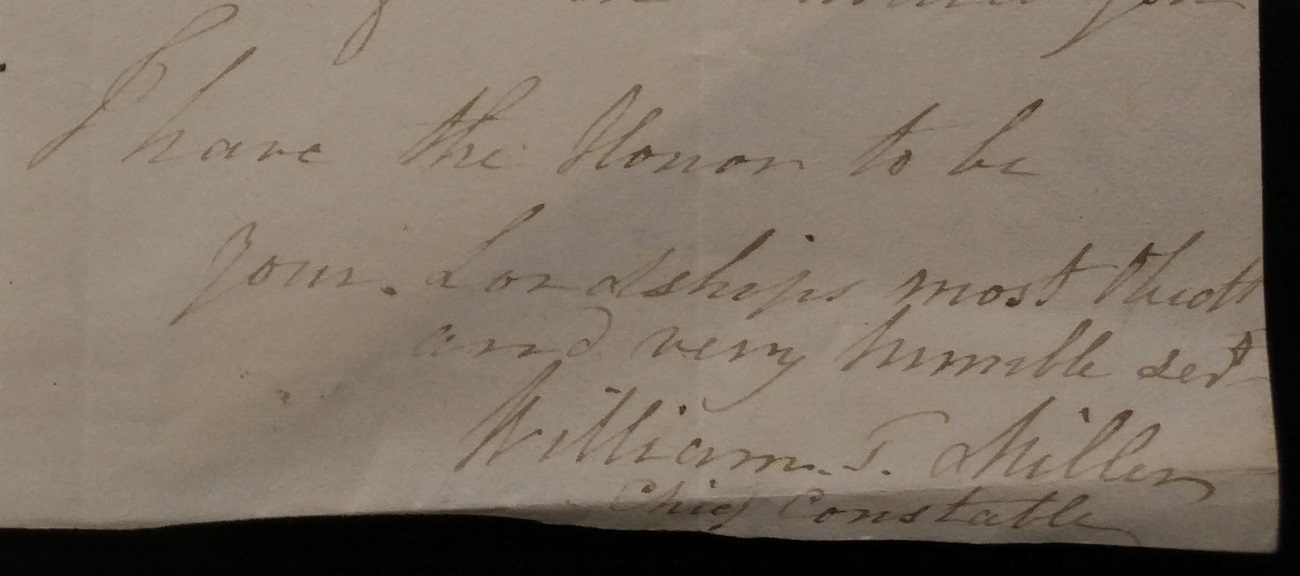
William Miller,
|
Policeman in South Co.Tipperary as at 1826-27:
He risked his life to take on Mathew Hogan (or Matthew), head of a group of Co.Tipperary faction fighters, "the Hogans". The story is told in [CSORP, 1827] and [Miller file, pleas in Sept and Oct 1830] and [CSORP, 1831]. On 10 July 1826 (NOT 1827), at the fair of Kilfeakle (Kilfeakle par, Barony of Clanwilliam), SW Co.Tipperary, Miller arrested faction fighter Mathew Hogan and other armed men. [CSORP, 1827] says Miller arrested "a man of most desperate character named Matthew Hogan, the head of a lawless faction". Miller says he arrested Hogan and the others "in view of upwards of 800 men, their comrades, all of whom were armed". He says: "every Fair and Market day in the County of Tipperary was a scene of bloodshed and murder until I at the risk of my life apprehended the leader of one of the most desperate Factions armed at the Head of Hundreds". He says Hogan's faction were "after committing many barbarous murders on that day as well as having disturbed the peace of the county with riots and murders for many years before". He brought a successful prosecution to conviction against Hogan and 6 of his party in the 1827 Spring Assizes at Clonmel. He says he prosecuted "the Hogans". Mathew Hogan was sentenced to transportation (would be to Australia). The faction threatened Miller's life, and he "was obliged to quit that County" [Co.Tipperary] "to avoid assassination". His father and himself had to leave Co.Tipperary in 1827 to avoid reprisals (this would suggest the family was from Co.Tipperary). The Grand Jurors of Co.Tipperary at Clonmel wrote a letter [CSORP, 1827] to Richard Wellesley, 1st Marquess Wellesley, Lord Lieutenant of Ireland. They confirm that Miller's life is threatened, "and he can not in consequence return to his home", and they recommend him to a post as Chief Constable, "as a spirited active young man". He got a commission in Co.Kerry to protect him from the faction "who were sworn to be revenged on me for being the cause of transporting their leader". |
Chief Constable of Listowel, Co.Kerry, 1827-29:
He was
appointed 1827 as Chief Constable
of Listowel,
Co.Kerry.
Apparently appointed Apr 1827
[CSORP, 1827].
He wrote from Listowel on 30 Mar 1828
[CSORP, 1828, no.410]
to William Gregory,
Under-Secretary for Ireland,
Dublin Castle.
He is worried about a report
"that a reduction will take place in the police establishment".
He says that if he loses his position his life will be at risk.
|
Miller got into trouble for being absent without leave in June 1828 (in the weeks before his wedding).
In [CSORP, 1828, no.946] there is a letter of Fri 13 June 1828 from Matthew Singleton, Sub-Inspector for Co.Kerry [RIC officers], writing from Tralee to Major William Miller, Inspector General for Munster, at Clonmel [RIC officers] (confusingly same name as our Miller). Singleton says he attended the Petty Sessions at Listowel on Thur 12 June, no police present. He found Miller had left Listowel on Wed 11 June, not due back until Sat 14 June. His letter formally reports Miller absent without leave. On 17 June 1828, Major William Miller forwards this report to William Gregory, Under-Secretary for Ireland, Dublin Castle. There is then a letter from Listowel, 18 June, from the Magistrates of Listowel to Major William Miller, saying they gave Miller permission. On 21 June 1828, Major William Miller forwards the Magistrates' letter to William Gregory, though he thinks it irregular. Miller is listed in marriage settlement as Chief Constable of police stationed at Listowel. Newspaper report of marriage lists him as "Chief of the Iraghticonnor Constabulary Force" (the whole area N of Listowel). |
He
mar 28 June 1828, Kilflynn, Co.Kerry,
to
Mary Ponsonby [bapt 20 February 1804,
descendant of
Henry VII].
Marriage settlement is about her Ponsonby inheritance.
It covers a sum of
£1,880,
the remainder of her inheritance of £2,000,
her share of the £4,000,
the remainder of the original £6,000 inheritance
on Ponsonby lands in Co.Kerry.
Marriage settlement witnessed by
William Ponsonby, junior, of Crotto
and John Herbert, carpenter, of Crotto.
They are living Listowel
as at
[Deed, Apr 1829, Crosbie].
[Patrick Carroll's Notebooks]
list him as Chief Constable of Listowel in 1829, living Listowel.
Chief Constable of Kilfinane, Co.Limerick, 1829-30:
He became Chief Constable of Kilfinane, Co.Limerick, 1829
[RIC officers].
He was at Listowel until at least 30 June 1829,
according to
[Miller file, letter of 10 May 1830].
He moved from Listowel to Kilfinane around 1 July 1829,
according to
[Miller file, letter of 8 May 1830].
He had moved to Co.Limerick by Sept 1829
[Miller file].
William T. Miller, chief constable, Kilfinane, Co.Limerick,
writes letter of 1 Oct 1829
to
George King, 3rd Earl of Kingston
about suspicious characters with firearms in his locality.
|
William Miller's investigation, arrest and dismissal, 1829-30:
There is a complaint about Miller, dated 11 Dec 1829 [Miller file] written by Mr. Smith, Sub-Inspector for Co.Limerick, from Rathkeale, Co.Limerick (this must be William Smith, see [RIC officers]), sent to Major William Miller, Inspector General for Munster. Smith complains that our Miller's reports are late or absent, "indeed since he came to this County, he has been generally late with any returns he has made." He says Miller is not responding to correspondence. He has sent Miller pay for his men, and the men are meant to return signatures that they got it, but: "There are three months' pay issued by me to his District without a single document in my possession to show that the men have been paid." There is a letter, 15 Dec 1829 [Miller file] from Major William Miller to the Chief Secretary for Ireland, Lord Francis Leveson-Gower, recommending that our Miller be suspended. He was suspended from the constabulary on 17 Dec 1829.
An Investigation was held at Bruff, Co.Limerick,
on 21 Jan 1830
(and reassembled at Limerick on 26 Jan).
A witness said they visited Kilfinane
and found Miller's police station with no food for the horses.
The investigation found that the horses had been neglected,
and that Miller had kept no proper accounts for horse supplies.
After he was dismissed,
Miller wrote a letter dated 28 Sept 1830
[Miller file]
to the
Lord Lieutenant
Hugh Percy, 3rd Duke of Northumberland,
pleading to be re-instated.
He attaches
a plea dated 25 Sept
outlining some of his history.
It says that after the Hogan case, his father and other relations
had to move to Co.Kerry too, to avoid reprisals.
He claims that his expenses are related to this rather than to any personal extravagance.
[CSORP, 1831]
says that when they moved, he became responsible for his father's debts.
There is an internal letter of 17 Nov 1830
[Miller file]
by Major William Miller,
about our Miller
"appropriating to his personal use"
a fine collected from a man for having unregistered arms.
|
William Miller is party to
[Deed, 1842]
about his wife's Ponsonby inheritance.
His wife is not listed as one of the parties.
She might be dead.
Not known if any issue.
In letters of 1830-31 above he said he had to take money in order not
"to see my family starve"
and of
"not having the means of supporting myself or wretched family",
but it is unclear who his "family" refers to.
James Miller,

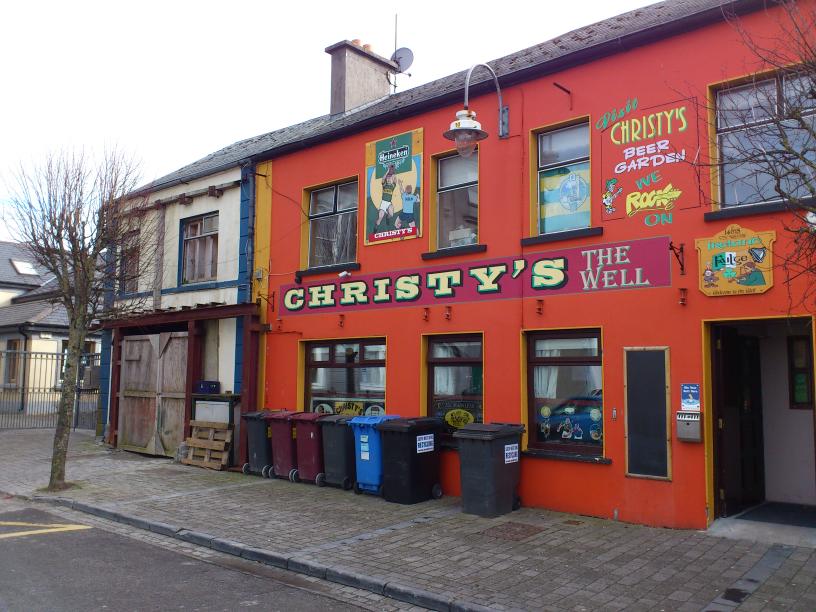
Christy's pub ("The Well"),
The Square, Listowel.
Photo 2013.
See full size.
See
other shot and
other shot and
other shot.
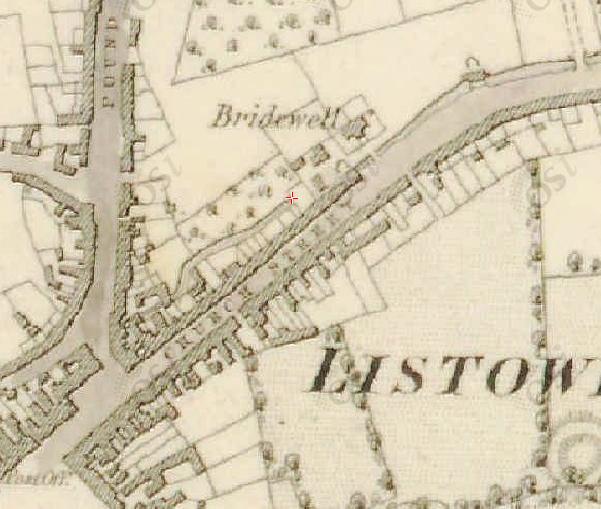
The "Bridewell"
(the prison),
Church St, Listowel.
From 1829 to 1842 map.
This is the site of the modern police station.
[Gaughan, 1974]
says that as at 1845
the modern police station site was the Bridewell.
A bridewell
sometimes had a police station attached,
but that does not seem to be the case here.
[Griffiths Valuation, 1852]
lists the Bridewell at
property no.70, Church St, Listowel,
but has a separate listing for the police barracks in The Square.
Church St used to be called Church Lane in the 19th century.
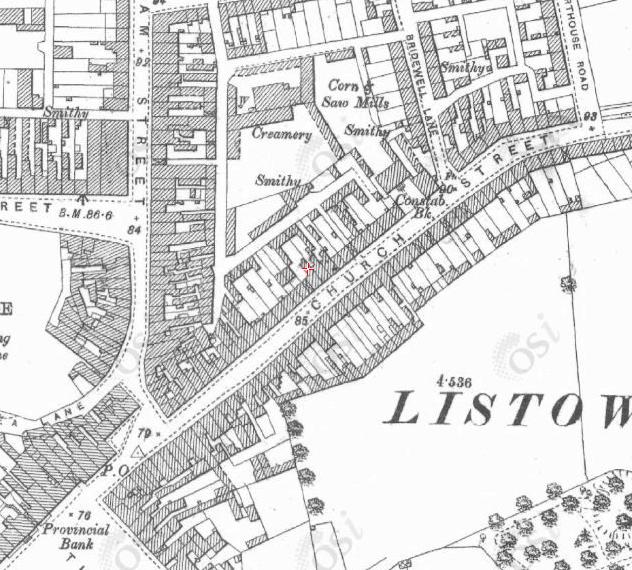
The constabulary barracks, Church St, Listowel (at Bridewell Lane, later called Forge Lane,
now Colbert St).
From 1887 to 1913 map.
The magnificent new Listowel RIC station (which stands today)
was built maybe around the 1880s
at the site of the old Bridewell.
See
Listowel police station
in 1901 census.
In 1918, Church St was renamed
Ashe St
but the new name did not catch on.
Listowel police station was in 1920 the site of the
Listowel Mutiny.
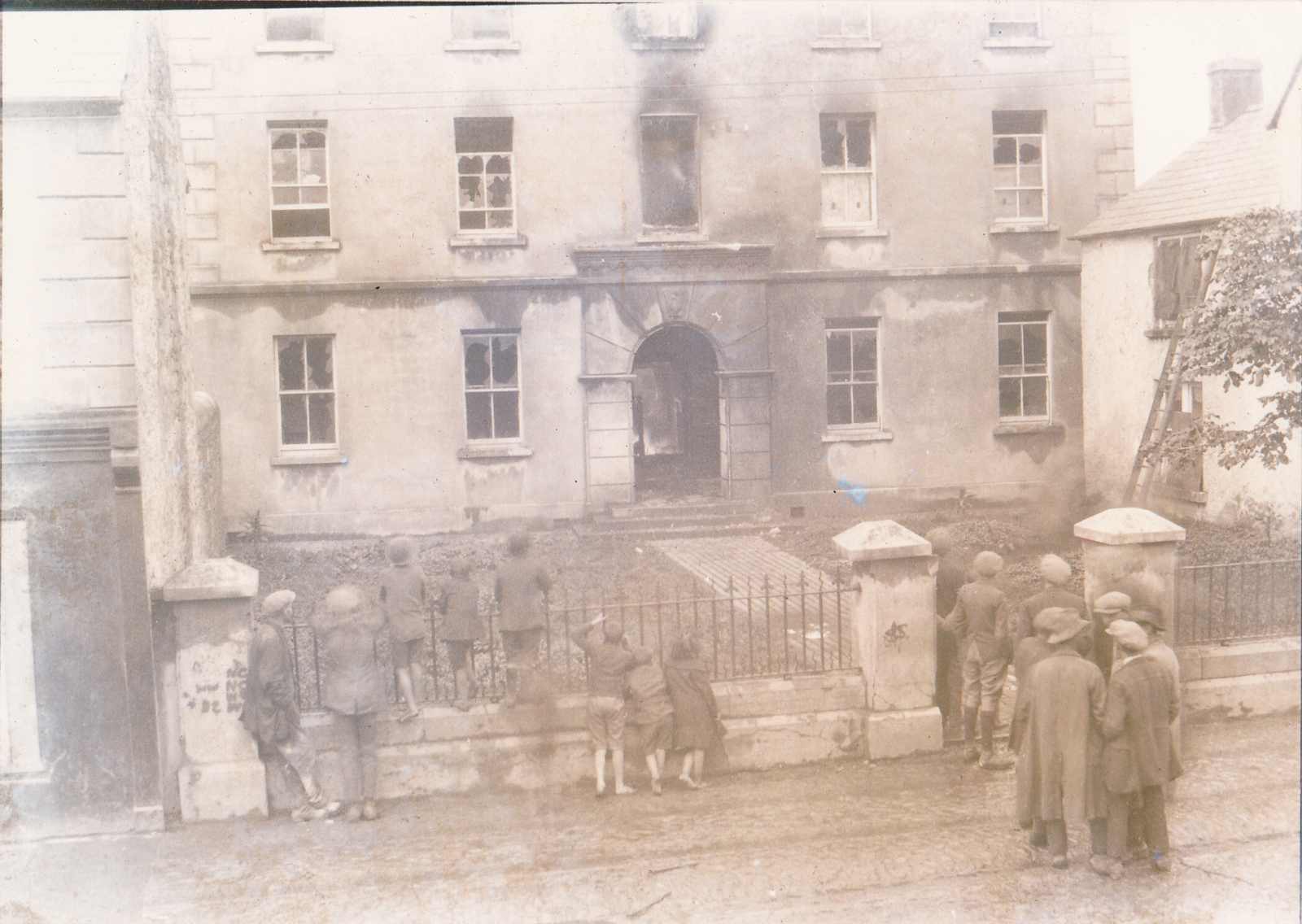
The burning of Listowel police station in the
Civil War,
Aug 1922.
Republicans held Listowel.
They burnt the police station
as Free State troops advanced on 3 Aug 1922.
See larger
and full size.
Courtesy of Vincent Carmody.
This building was restored, and today is the impressive Listowel Garda station, Church St.
See
Google Street View.
Please donate to support this site.
I have spent a great deal of time and money on this research.
Research involves travel and many expenses.
Some research "things to do"
are not done for years, because I do not have the money to do them.
Please Donate Here
to support the ongoing research and
to keep this website free.